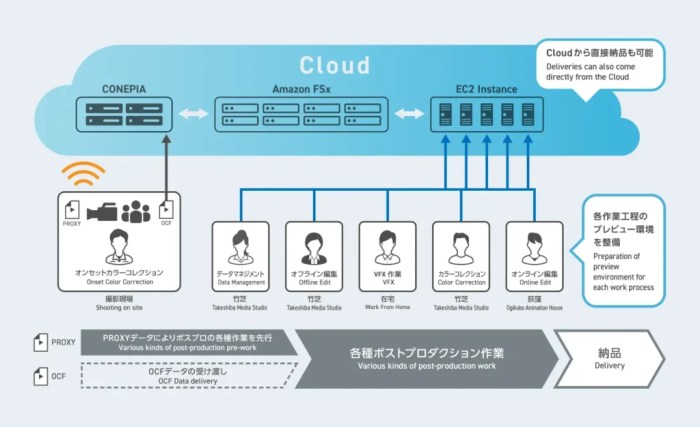Integrating Business Workflow Systems with Cloud Solutions sets the stage for this enthralling narrative, offering readers a glimpse into a story that is rich in detail and brimming with originality from the outset. As businesses navigate the digital landscape, the fusion of workflow systems with cloud solutions emerges as a pivotal strategy, driving efficiency, collaboration, and innovation to new heights.
In this article, we delve into the intricacies of this integration, exploring the key concepts, factors to consider, best practices, and real-world case studies that illuminate the path to seamless implementation.
Overview of Integrating Business Workflow Systems with Cloud Solutions

Integrating business workflow systems with cloud solutions involves connecting the processes and tools used within a company to cloud-based platforms for improved efficiency, collaboration, and scalability. This integration allows businesses to streamline their workflows, automate repetitive tasks, and access data from anywhere with an internet connection.
Examples of Popular Cloud Solutions for Workflow Integration
- Microsoft Azure: Offering a wide range of services for application development, analytics, and storage, Azure is a popular choice for businesses looking to integrate their workflow systems with the cloud.
- Google Workspace: Formerly known as G Suite, Google Workspace provides tools like Gmail, Google Drive, and Google Docs to enhance collaboration and productivity within organizations.
- Amazon Web Services (AWS): With a vast selection of cloud computing services, AWS enables businesses to build scalable and secure workflows tailored to their specific needs.
Benefits of Integrating Business Workflow Systems with Cloud Solutions
- Scalability: Cloud solutions allow businesses to easily scale their workflow systems up or down based on demand, without the need for extensive hardware upgrades.
- Cost-efficiency: By eliminating the need for on-premises infrastructure and maintenance, cloud integration can reduce operational costs and capital expenditures.
- Flexibility: Cloud solutions offer flexibility in accessing and managing workflows remotely, enabling employees to work from anywhere and on any device.
- Collaboration: Cloud-based workflow systems promote collaboration among team members by providing real-time access to shared documents, communication tools, and project management platforms.
Factors to Consider Before Integrating Business Workflow Systems with Cloud Solutions
When integrating business workflow systems with cloud solutions, several key factors need to be carefully considered to ensure a successful transition. These factors include security, scalability, cost-effectiveness, compatibility with existing systems, and data migration strategies.
Security
Security is a critical factor to consider when integrating business workflow systems with cloud solutions. It is essential to ensure that the cloud provider offers robust security measures to protect sensitive business data. This includes encryption, access controls, data backups, and compliance with industry regulations such as GDPR.
Scalability
Scalability is another important consideration, especially for growing businesses. The cloud solution should be able to scale seamlessly to accommodate increased workload and user demands without compromising performance. It is crucial to choose a cloud provider that offers flexible scalability options to meet the evolving needs of the business.
Cost
Cost-effectiveness is a key factor when integrating business workflow systems with cloud solutions. It is essential to consider not only the initial setup costs but also ongoing maintenance, upgrades, and subscription fees. A thorough cost-benefit analysis should be conducted to determine the overall affordability and return on investment of the cloud solution.
Compatibility with Business Workflow Systems
When selecting a cloud solution, it is important to consider its compatibility with existing business workflow systems. The cloud solution should seamlessly integrate with the current systems and applications used by the organization to ensure smooth operations and minimal disruption during the transition process.
Data Migration Strategies
Data migration is a crucial aspect of integrating business workflow systems with cloud solutions. A well-defined data migration strategy should be developed to ensure a smooth and efficient transfer of data from on-premises systems to the cloud. This includes identifying data dependencies, mapping data structures, testing data integrity, and implementing proper data migration tools and techniques.
Best Practices for Seamless Integration
When integrating business workflow systems with cloud solutions, it is crucial to follow best practices to ensure a smooth transition and maximize efficiency
Selecting the Right Integration Tools and Platforms
- Research and compare different integration tools to find the one that best fits your business needs.
- Consider factors such as scalability, ease of use, compatibility with existing systems, and security features.
- Look for platforms that offer robust APIs and support for various cloud services to enable seamless integration.
Optimizing Workflows Post-Integration
- Regularly review and analyze workflows to identify areas for improvement and optimization.
- Automate repetitive tasks and streamline processes to increase efficiency and reduce manual errors.
- Train employees on the new integrated system to ensure they understand how to utilize it effectively.
Case Studies of Successful Integrations
Integrating business workflow systems with cloud solutions has become increasingly common among companies looking to streamline their operations and improve efficiency. Let's take a look at some real-world examples of successful integrations and the impact they had on the organizations.
Company A: Streamlining Operations
- Company A, a multinational corporation in the manufacturing industry, integrated their business workflow systems with cloud solutions to centralize data and automate processes.
- This integration resulted in a significant reduction in manual tasks, improved collaboration among teams, and real-time access to critical information.
- Despite initial challenges related to data migration and system compatibility, Company A successfully overcame these obstacles through thorough planning and effective communication with stakeholders.
Company B: Boosting Productivity
- Company B, a tech startup specializing in e-commerce, integrated their workflow systems with cloud solutions to enhance scalability and flexibility.
- By leveraging cloud-based tools for project management and communication, Company B saw a notable increase in productivity and efficiency across departments.
- During the integration process, Company B faced challenges related to data security and user training, which were addressed through implementing robust security measures and conducting comprehensive training sessions.
Company C: Improving Bottom Line
- Company C, a financial services firm, integrated their workflow systems with cloud solutions to optimize resource allocation and reduce operational costs.
- Through automation of repetitive tasks and seamless data sharing enabled by the cloud, Company C was able to achieve significant cost savings and improve profitability.
- While navigating the integration process, Company C encountered challenges related to compliance requirements and system customization, which were resolved through collaboration with external consultants and software vendors.
End of Discussion

As we conclude this exploration of Integrating Business Workflow Systems with Cloud Solutions, one thing becomes abundantly clear - the transformative power of this synergy cannot be overstated. From enhanced productivity to streamlined operations, the possibilities are endless. Embrace this paradigm shift and unlock the full potential of your business in the digital age.
Answers to Common Questions
How can cloud solutions benefit business workflow systems?
Cloud solutions offer scalability, flexibility, and enhanced collaboration capabilities for business workflow systems, leading to increased efficiency and productivity.
What are the key security considerations when integrating workflow systems with cloud solutions?
Key security considerations include data encryption, access controls, compliance with industry regulations, and regular security audits to ensure data protection.
How can businesses optimize workflows post-integration for maximum efficiency?
Businesses can optimize workflows by automating repetitive tasks, streamlining approval processes, and leveraging analytics to identify bottlenecks and areas for improvement.













